Metal-Oxides- and Metal-Oxyhydroxides-Based Nanocomposites for Water Splitting: An Overview
Abstract
1. Introduction
2. OxH-Based Nanomaterials for Water Splitting
3. Transition Metal OxH Based Electrodes for OER
4. Transition Metal OxH Based Materials for HER
5. Mixed Transition Metal OxHs for the OER and HER
6. Rare-Earth Metal Oxide/OxH for OER and HER
7. Polymer-Based Metal OxHs for OER and HER
8. MXene-Supported Metal OxHs for OER and HER
9. Solid Supports for Metal OxHs for OER and HER
10. Conclusions
Author Contributions
Funding
Data Availability Statement
Conflicts of Interest
Abbreviations
| OER | Oxygen evolution reaction |
| HER | Hydrogen evolution reaction |
| OxHs | Oxyhydroxides |
| HT | Hydrothermal |
| ORR | Oxygen reduction reaction |
| DFT | Density functional theory |
| EC | Electrochemical |
References
- Zhou, H.; Li, H.; Li, L.; Liu, T.; Chen, G.; Zhu, Y.; Zhou, L.; Huang, H. Structural composite energy storage devices—A review. Mater. Today Energy 2022, 24, 100924. [Google Scholar] [CrossRef]
- Zhang, R.; Cheng, L.Z.; Wang, Z.; Kong, F.Y.; Tsegazab, Y.; Lv, W.X.; Wang, W. Ni3S2Co9S8 heterostructure nanowire supported on Ni foam as highly efficient and stable electrocatalyst for oxygen evolution reaction. Appl. Surf. Sci. 2020, 526, 146753. [Google Scholar] [CrossRef]
- Roger, I.; Shipman, M.A.; Symes, M.D. Earth abundant catalyst for electrochemical and photo electrochemical water splitting. Nat. Rev. Chem. 2017, 1, 0003. [Google Scholar] [CrossRef]
- Wang, H.; Ren, X.; Chen, J.; Xu, W.; He, Q.; Wang, H.; Zhan, F.; Chen, L. Recent advances of emerging oxyhydroxide for electrochemical energy storage applications. J. Power Sources 2023, 554, 232309. [Google Scholar] [CrossRef]
- Yu, C.; Lu, J.; Luo, L.; Xu, F.; Shen, P.K.; Tsiakaras, P.; Yin, S. Bifunctional catalysts for overall water splitting: CoNi oxyhydroxide nanosheets electrodeposited on titanium sheets. Electrochimi. Acta 2019, 301, 449–457. [Google Scholar] [CrossRef]
- Lee, S.; Chu, Y.C.; Bai, L.; Chen, H.M.; Hu, X. Operando identification of a side-on nickel superoxide intermediate and the mechanism of oxygen evolution on nickel oxyhydroxide. Chem. Catal. 2023, 3, 100475. [Google Scholar] [CrossRef]
- Guo, B.; Huo, H.; Zhuang, Q.; Ren, X.; Wen, X.; Yang, B.; Huang, X.; Chang, Q.; Li, S. Iron oxyhydroxide: Structure and applications in electrocatalytic oxygen evolution reaction. Adv. Funct. Mater. 2023, 23, 2300557. [Google Scholar] [CrossRef]
- Kim, T.W.; Choi, K.S. Nanoporous photoanodes with dual-layer oxygen evolution catalyst for solar water-splitting. Science 2014, 343, 990–994. [Google Scholar] [CrossRef] [PubMed]
- Landon, J.; Demeter, E.; Inoglu, N.; Keturakis, C.; Wachs, I.E.; Vasic, R.; Frenkel, A.I.; Kitchin, J.R. Spectroscopic characterization of mixed Fe-Ni oxide electrocatalysts for the oxygen evolution reaction in alkaline electrolytes. ACS Catat. 2012, 2, 1793–1801. [Google Scholar] [CrossRef]
- Sorochkina, K.; Smotraiev, R.; Chepurna, I. Zirconium and aluminium oxyhydroxides particles formation during sol-gel process. Colloids Surf. A Phys. Eng. Aspects 2015, 484, 56–61. [Google Scholar] [CrossRef]
- Mikhaylov, V.I.; Maslennikova, T.P.; Ugolkov, U.L.; Krivoshapkin, P.V. Hydrothermal synthesis, characterization and sorption properties of AC/Fe oxide-oxyhydroxide composite powders. Adv. Power Technol. 2016, 27, 756–764. [Google Scholar] [CrossRef]
- Motlagh, M.M.K.; Youzbashi, A.A.; Hashemzadeh, F.; Sabaghadeh, L. Structural properties of nickel hydroxides/oxyhydroxide and oxide nanoparticles obtained by microwave assisted oxidation technique. Powder Technol. 2013, 237, 562–568. [Google Scholar] [CrossRef]
- Wong, K.C.; Goh, P.S.; Suzaimi, N.D.; Ahmad, N.A.; Lim, J.W.; Ismail, A.F. Copper catalyzed FeOOH template method for accelerated fabrication of ultraporous membranes used in microalgae dewatering. Chem. Eng. J. 2023, 453, 139827. [Google Scholar] [CrossRef]
- Xue, Z.; Wang, Y.; Yang, M.; Wang, T.; Zhu, H.; Rui, Y.; Wu, S.; An, W. In-situ construction of electrodeposited polyaniline/nickel-iron oxyhydroxide stabilized on nickel foam for efficient oxygen evolution reaction at high current densities. Int. J. Hydrogen Energy 2022, 47, 34025–34035. [Google Scholar] [CrossRef]
- Fan, H.; Song, J.; Bai, L.; Wang, Y.; Jin, Y.; Liu, S.; Xie, X.; Zheng, W.; Liu, W. Zn substituted hydroxide/oxyhydroxide heterostructure activates proton conduction. Energy Storage Mater. 2023, 55, 84–93. [Google Scholar] [CrossRef]
- Lawrence, M.J.; Kolodziej, A.; Rodriquez, P. Controllable synthesis of nanostructured metal oxide and oxyhydroxide materials via electrochemical methods. Curr. Opin. Electrochem. 2018, 10, 7–15. [Google Scholar] [CrossRef]
- Miao, Y.; Quyang, R.; Zhou, S.; Xu, L.; Yang, Z.; Xiao, M.; Quyang, R. Electrocatalysis and electroanalysis of nickel, its oxides, hydroxides and oxyhydroxides toward small molecules. Biosens. Bioelectron. 2014, 53, 428–439. [Google Scholar] [CrossRef]
- Fleischman, M.; Korinek, K.; Pletcher, D. The oxidation of organic compounds at a nickel anode in alkaline solutions. J. Electroanal. Chem. Interfacial Electrochem. 1971, 31, 39–49. [Google Scholar] [CrossRef]
- Chen, Z.; Wang, X.; Kebler, S.; Fan, O.; Huang, M.; Colfen, H. Synthesis of hierarchical transition metal oxyhydroxides in aqueous solution at ambient temperature and their application as OER electrocatalysts. J. Energy Chem. 2022, 71, 89–97. [Google Scholar] [CrossRef]
- Mallick, L.; Rajput, A.; Adak, M.K.; Kundu, A.; Choudhary, P.; Chakraborty, B. γ-FeO (OH) with multiple surface terminations: Intrinsically active for the electrocatalytic oxygen evolution reaction. Dalton Trans. 2022, 51, 15094–15110. [Google Scholar] [CrossRef]
- El Issmaeli, Y.; Lahrichi, A.; Kalanur, S.S.; Natarajan, S.K.; Pollet, B.G. Recent advances and prospects of FeOOH-based electrode materials for supercapacitors. Batteries 2023, 9, 259. [Google Scholar] [CrossRef]
- Liang, C.; Zou, P.; Nairan, A.; Zhang, Y.; Liu, J.; Liu, K.; Hu, S.; Kang, F.; Fan, H.J.; Yang, C. Exceptional performance of hierarchical Ni–Fe oxyhydroxide@ NiFe alloy nanowire array electrocatalysts for large current density water splitting. Energy. Environ. Sci. 2020, 13, 86–95. [Google Scholar] [CrossRef]
- Saidin, N.U.; Choo, T.F.; Yunus, R.M.; Zali, N.M.; Kok, K.Y.; Wong, W.Y.; Lim, K.L. One-pot gamma radiolysis synthesis of a graphene oxide supported cobalt oxyhydroxide electrocatalyst for oxygen reduction reaction. Radiat. Phys. Chem. 2023, 205, 110680. [Google Scholar] [CrossRef]
- Yue, Y.; Niu, J.; Yang, C.; Qin, J.; Zhang, X.; Liu, R. The OER/ORR activities of copper oxyhydroxides series electrocatalysts. Mol. Catal. 2023, 537, 112942. [Google Scholar] [CrossRef]
- Hefnawy, M.A.; Fadlallah, S.A.; Shrif, R.M.E.; Medany, S.S. Nickel-manganese double hydroxide mixed with reduced graphene oxide electrocatalyst for efficient ethylene glycol electrooxidation and hydrogen evolution reaction. Syn. Metals 2021, 282, 116959. [Google Scholar] [CrossRef]
- Tai, J.; Bi, Y.; Ni, C.; Wu, X.; Koudama, T.D.; Cui, S.; Shen, X.; Chen, X. Modulating interfacial charge density of FeCo oxyhydroxides via coupling with graphene oxide aero-gel for boosting oxygen evolution reaction. J. Alloy. Compd. 2023, 934, 167911. [Google Scholar] [CrossRef]
- Chen, G.; Du, J.; Wang, X.; Shi, X.; Wang, Z.; Liang, H.P. Iron-induced 3D nanoporous iron-cobalt oxyhydroxide on carbon cloth as a highly efficient electrode for oxygen evolution reaction. Chin. J. Catal. 2019, 40, 1540–1547. [Google Scholar] [CrossRef]
- Lee, S.; Kim, M.C.; Lang, A.R.; Sohn, J.I.; Park, J.B.; Lee, Y.W. Spindle-shape ferric oxyhydroxides with nano-sized grains for efficient oxygen evolution reaction and supercapacitors. Appl. Surf. Sci. 2022, 577, 151975. [Google Scholar] [CrossRef]
- Zhao, C.; Li, J.; Yang, M.; Chen, J.; Xie, F.; Wang, N.; Jin, Y.; Yu, X.; Meng, H. S/Se dural-doping promotes the formation of active Ni/Fe oxyhydroxide for oxygen evolution reaction of (sea) water splitting. Int. J. Hydrogen Energy 2022, 47, 21753–21759. [Google Scholar] [CrossRef]
- Chen, L.; Wang, Y.; Zhao, X.; Wang, Y.; Li, Q.; Wang, Q.; Tang, Y.; Lei, Y. Trimetallic oxyhydroxides as active sites for large-current density alkaline oxygen evolution and overall water splitting. J. Mater. Sci. Technol. 2022, 110, 128–135. [Google Scholar] [CrossRef]
- Jia, N.; Liu, J.; Liu, Y.; Wang, L.; Chen, P.; An, Z.; Chen, X.; Chen, Y. In situ conversion of iron sulfide (FeS) to iron oxyhydroxide (γ-FeOOH) on N,S Co-doped porous carbon nanosheets: An efficient electrocatalyst for the oxygen reduction reaction and zinc-air batteries. J. Colloids Interface Sci. 2020, 558, 323–333. [Google Scholar] [CrossRef] [PubMed]
- Kim, G.P.; Lim, D.; Park, I.; Park, H.; Shim, S.E.; Baeck, S.H. RuO2 nanoparticles decorated MnOOH/C as efficient bi-functional electrocatalysts for lithium-air battery cathode with long-cycling stability. J. Power Sources 2016, 324, 687–693. [Google Scholar] [CrossRef]
- Putra, R.P.; Rachman, I.B.; Horino, H.; Rzeznicka, I.I. Bi-functional catalytic activity of γ-NiOOH toward oxygen reduction and oxygen evolution reactions in alkaline solutions. Oxygen 2022, 2, 479–492. [Google Scholar] [CrossRef]
- Babar, P.; Patil, K.; Mohmood, J.; Kim, S.; Kim, J.H.; Yavuz, C.T. Low-overpotential overall water splitting by a co-operative interface of cobalt-iron hydroxide and iron oxyhydroxide. Cell Rep. Phys. Sci. 2022, 3, 100762. [Google Scholar] [CrossRef]
- Duan, R.; Li, Y.; Gong, S.; Tong, Y.; Li, Z.; Qi, W. Hierarchical CoFe oxyhydroxides nanosheets and Co2P nanoparticles grown on Ni foam for overall water splitting. Electrochim. Acta 2020, 360, 136994. [Google Scholar] [CrossRef]
- Tee, S.Y.; Win, K.Y.; Teo, W.S.; Koh, L.D.; Teng, C.P.; Han, M.Y. Recent progress in energy-driven water splitting. Adv. Sci. 2017, 4, 1600337. [Google Scholar] [CrossRef] [PubMed]
- Anantharaj, S.; Sugime, H.; Noda, S. Surface amorphized nickel hydroxyl sulphise for efficient hydrogen evolution reaction in alkaline medium. Chem. Eng. J. 2021, 408, 127275. [Google Scholar] [CrossRef]
- Huang, Y.; Wei, G.; He, J.; An, C.; Hu, M.; Shu, M.; Zhu, J.; Yao, S.; Xi, W.; Si, R.; et al. Interfacial electronic interaction of automatically dispersed IrClx on ultrathin Co(OH)2/CNTs for efficient electrocatalytic water oxidation. Appl. Catal. B Environ. 2020, 279, 119398. [Google Scholar] [CrossRef]
- Ramírez, A.M.; Heidari, S.; Vergara, A.; Aguilera, M.V.; Preuss, P.; Camarada, M.B.; Fischer, A. Rhenium-Based Electrocatalysts for Water Splitting. ACS Mater. Au 2023, 3, 177–200. [Google Scholar] [CrossRef]
- Zhao, J.W.; Li, C.F.; Shi, Z.X.; Guan, J.L.; Li, G.R. Boosting lattice oxygen oxidation of perovskite to efficiently catalyze oxygen evolution reaction by FeOOH decoration. Research 2020, 2020, 6961578. [Google Scholar] [CrossRef]
- Peng, X.; Pi, C.; Zhang, X.; Li, S.; Huo, K.; Chu, P.K. Recent progress of transition metal nitrides for efficient electrocatalytic water splitting. Sustain. Energy Fuels 2019, 3, 366–381. [Google Scholar] [CrossRef]
- Shi, H.; Liang, H.; Ming, F.; Wang, Z. Efficient overall water splitting electrocatalysis using lepidocrocite VOOH hollow nanospheres. Angew. Chem. Int. Ed. 2017, 129, 588–592. [Google Scholar] [CrossRef]
- Zhang, P.; Gong, L.; Tan, Y. Ni1− 2x MoxSe nanowires@ ammonium nickel phosphate–MoOx heterostructures as a high performance electrocatalyst for water splitting. Sustain. Energy. Fuels 2021, 5, 5581–5593. [Google Scholar] [CrossRef]
- Kim, Y.K.; Kim, I.H.; Jo, Y.H.; Lee, J.S. Precipitating metal nitrate deposition of amorphous metal oxyhydroxide electrodes containing Ni, Fe and Co for electrocatalytic water oxidation. ACS Catal. 2019, 9, 9650–9662. [Google Scholar] [CrossRef]
- Badreldin, A.; Nabeech, A.; Youssef, E.; Mubarak, N.; Elsayed, H.; Mohsen, R.; Ahmed, F.; Wubulikasimu, Y.; Elsaid, K.; Wahab, A.A. Adapting early transition metal and nonmetallic dopants on CoFe oxyhydroxides for enhanced alkaline and neutral pH saline water oxidation. ACS Appl. Energy Mater. 2021, 4, 6942–6956. [Google Scholar] [CrossRef]
- Zhang, Z.; He, B.; Chen, B.; Wang, H.; Wang, R.; Zho, L.; Gong, Y. Boosting overall water splitting via FeOOH nanoflakes decorated PrBa0.5Sr0.5Co2O5+δ nanorods. ACS Appl. Mater. Interfaces 2018, 10, 38032–38041. [Google Scholar] [CrossRef]
- Tsai, F.T.; Wang, H.C.; Ke, C.H.; Liaw, W.F. FeCo/FeCoPxOy(OH)2 as bifunctional electrodeposited film electrodes for overall water splitting. ACS Appl. Energy Mater. 2018, 1, 5298–5307. [Google Scholar] [CrossRef]
- Kou, Z.; Yu, Y.; Liu, X.; Gao, X.; Zheng, L.; Zou, H.; Pang, Y.; Wang, Z.; Pan, Z.; He, J.; et al. Potential dependent phase transition and Mo enriching surface reconstruction of γ-CoOOH in heterostructured Co-Mo2C pre-catalyst enable water oxidation. ACS Catal. 2020, 10, 4411–4419. [Google Scholar] [CrossRef]
- Wang, P.; Lin, Y.; Xu, Q.; Wan, L.; Xu, Z.; Wang, B. The FeOOH decorated Fe-doped nickel selenide hierarchical array for high-performance water oxidation. Ind. Eng. Chem. Res. 2022, 61, 6146–6155. [Google Scholar] [CrossRef]
- Moi, C.T.; Sahu, A.; Qureshi, M. Tapping the potential of high-valent Mo and W metal centres for dynamic electronic structure in multi-metallic FeVO(OH)Ni(OH)2 for ultrastable and efficient overall water splitting. ACS Appl. Mater. Interfaces 2023, 15, 5336–5344. [Google Scholar] [CrossRef]
- Vazhayil, A.; Vazhayal, L.; Thomas, J.; Ashok, S.; Thomas, N. A comprehensive review on the recent developments in transition metal based electrocatalysts for oxygen evolution reaction. Appl. Surf. Sci. Adv. 2021, 6, 100184. [Google Scholar] [CrossRef]
- Ghouri, Z.K.; Elsaid, K.; Nasef, M.M.; Ahmed, S.; Badreldin, A.; Wahab, A.A. Cooperative electrocatalytic effect of Pd and Ce alloys nanoparticles in PdCe@CNWs electrodes for oxygen evolution reaction (OER). Mol. Catal. 2022, 522, 112255. [Google Scholar] [CrossRef]
- Pal, S.; Jana, S.; Kumar, A.; Parakash, R.R. Enhanced OER properties from nanocomposites of Co3O4 and MOF derived N/S/Zn-doped porous carbon. Electrochim. Acta 2022, 436, 141436. [Google Scholar] [CrossRef]
- Zhang, R.; Liu, W.; Zhang, F.M.; Yang, Z.D.; Zhang, G.; Zeng, X.C. CoF-C4N nanosheets with uniformly anchored single metal sites for electrocatalytic OER: From theoretical screening to target synthesis. Appl. Catal. B Environ. 2023, 325, 122366. [Google Scholar] [CrossRef]
- Dionigi, F.; Strasser, P. NiFe-based (oxy)hydroxide catalysts for oxygen evolution reaction in non-acidic electrolytes. Adv. Energy Mater. 2016, 6, 1600621. [Google Scholar] [CrossRef]
- Sun, X.; Guan, X.; Feng, H.; Zheng, D.; Tian, W.; Li, C.; Li, C.; Yan, M.; Yao, Y. Enhanced activity promoted by amorphous metal oxyhydroxides on CeO2 for alkaline oxygen evolution reaction. J. Colloid Interface Sci. 2021, 604, 719–726. [Google Scholar] [CrossRef]
- Park, J.H.; Woo, S.; Lee, J.; Jung, H.Y.; Ro, J.C.; Park, C.; Lim, B.; Suh, S.J. Facile modified polyol synthesis of FeCo nanoparticles with oxyhydroxide surface layer as efficient oxygen evolution reaction electrocatalysis. Int. J. Hydrog. Energy 2021, 46, 15398–15409. [Google Scholar] [CrossRef]
- Kim, B.; Kabraz, M.K.; Lee, J.; Choi, C.; Baik, H.; Jung, Y.; Oh, H.S.; Choi, S.I.; Lee, K. Vertically-crystalline Fe-doped β-Ni oxyhydroxides for highly active and stable oxygen evolution reaction. Matter 2021, 4, 3585–3604. [Google Scholar] [CrossRef]
- Shao, B.; Pang, W.; Tan, X.Q.; Tang, C.; Deng, Y.; Huang, D.; Huang, J. Rapid growth of amorphous cobalt-iron oxyhydroxide nanosheet arrays on to iron foam: Highly efficient and low-cost catalyst for oxygen evolution. J. Electroanal. Chem. 2019, 856, 113621. [Google Scholar] [CrossRef]
- Wang, J.; Zhang, W.; Zheng, Z.; Liu, J.; Yu, C.; Chen, Y.; Ma, K. Dendric core-shell Ni@Ni(Fe)OOH metal/metal oxyhydroxide electrode for efficient oxygen evolution reaction. Appl. Surf. Sci. 2019, 469, 731–738. [Google Scholar] [CrossRef]
- Guio, C.G.M.; Liardet, L.; Hu, X. Oxidatively electrodeposited thin-film transition metal (oxy)hydroxides as oxygen evolution catalysts. J. Am. Chem. Soc. 2016, 138, 8946–8957. [Google Scholar] [CrossRef] [PubMed]
- Li, Y.; Lin, X.; Du, J. Iron-facilitated transformation of mesoporous spinel nanosheets in to oxyhydroxide active species in the oxygen evolution reaction. Inorg. Chem. 2021, 60, 19373–19380. [Google Scholar] [CrossRef] [PubMed]
- He, Q.; Xie, H.; Rehman, Z.; Wang, C.; Wan, P.; Jiang, H.; Chu, W.; Song, L. Highly defective Fe-based oxyhydroxides from electrochemical reconstruction for efficient oxygen evolution catalysis. ACS Energy Lett. 2018, 3, 861–868. [Google Scholar] [CrossRef]
- Shamraiz, U.; Badsha, A.; Raza, B.; Green, I.R. First principle study on chromium substituted α-cobalt oxyhydroxides for efficient oxygen evolution reaction. ACS Appl. Energy Mater. 2020, 3, 6486–6491. [Google Scholar] [CrossRef]
- Deshpande, N.G.; Kim, D.S.; Ahn, C.H.; Jung, S.H.; Kim, Y.B.; Lee, H.S.; Cho, H.K. β-like FeOOH nanoswords activated by Ni foam and encapsulated by rGO towards high current densities durability and efficient oxygen evolution. ACS Appl. Mater. Interfaces 2021, 13, 18772–18783. [Google Scholar] [CrossRef]
- Niu, S.; Sun, Y.; Rakov, D.; Li, Y.; Ma, Y.; Chu, J.; Xu, P. Stepwise electrochemical construction of FeOOH/Ni(OH)2 on Ni foam for enhanced electrocatalytic oxygen evolution. ACS Appl. Energy Mater. 2019, 2, 3927–3935. [Google Scholar] [CrossRef]
- Zhang, Y.; You, L.; Liu, Q.; Li, Y.; Li, T.; Xue, Z.; Li, G. Interfacial charge transfer in a hierarchical Ni2P/FeOOH heterojunction facilitates electrocatalytic oxygen evolution. ACS Appl. Mater. Interfaces 2021, 13, 2765–2771. [Google Scholar] [CrossRef]
- Anantharaja, S.; Noda, S.; Jothi, V.R.; Yi, J.S.; Driess, M.; Menezes, P.W. Strategies and perspectives to catch the missing pieces in energy efficient hydrogen evolution reaction in alkaline media. Angew. Chem. Int. Ed. 2021, 60, 2–28. [Google Scholar]
- Cheng, J.; Wang, D. 2D materials modulating layered double hydroxides for electrocatalytic water splitting. Chin. J. Catal. 2022, 43, 1380–1398. [Google Scholar] [CrossRef]
- Liu, Y.; Ding, M.; Tian, Y.; Zhao, G.; Huang, J.; Xu, X. In-situ growth of 3D hierarchical γ-FeOOH/Ni3S2 heterostructure as high performance electrocatalyst for overall water splitting. J. Colloid Interface Sci. 2023, 639, 24–32. [Google Scholar] [CrossRef]
- Zhang, K.; Wang, F.; Li, X.; Wang, S.; Wang, Y.; Zha, Q.; Ni, Y. Connected design of Ni-foam supported porous Ni and FeOOH/porous Ni electrocatalysis for overall water splitting in alkaline media. J. Alloy. Compd. 2023, 942, 169014. [Google Scholar] [CrossRef]
- Lv, Q.; Zhang, W.; She, L.; Ren, W.; Hou, L.; Fautrelle, Y.; Lu, X.; Yu, X. Controlled direct electrodeposition of crystalline NiFe/amorphous NiFe (oxy)hydroxide on NiMo-alloy as a highly efficient bi-fucntional electrocatalyst for overall water splitting. Chem. Eng. J. 2022, 446, 137420. [Google Scholar] [CrossRef]
- Mu, W.; Bao, D.; Chang, C. Growth of nickel vacancy NiFe-LDHs on Ni(OH)2 nanosheets as highly efficient bi-functional electrocatalyst for overall water splitting. Int. J. Hydrog. Energy 2022, 47, 15603–15611. [Google Scholar] [CrossRef]
- Liu, H.; Cao, S.; Zhang, J.; Liu, S.; Chen, C.; Zhang, Y.; Wei, S.; Wang, Z.; Lu, X. Facile control of surface reconstruction with Co2+ or Co3+-rich (oxy)hydroxide surface on ZnCo phosphate for large-current-density hydrogen evolution in alkali. Mater. Today Phys. 2021, 20, 100448. [Google Scholar] [CrossRef]
- Li, X.; Hu, Q.; Wang, H.; Chen, M.; Hao, X.; Ma, Y.; Liu, J.; Tang, K.; Abudula, A.; Guan, G. Charge induced crystal distortion and morphology remodeling: Formation of Mn-CoP nanowire@Mn-COOH nanosheet electrocatalyst with rich edge dislocation defects. Appl. Catal. B Environ. 2021, 292, 120172. [Google Scholar] [CrossRef]
- Anantharaj, S.; Subhashini, E.; Swaathini, K.C.; Amarnath, T.C.; Chatterjee, S.; Karthick, K.; Kundu, S. Respective influence of stoichiomery and NiOOH formation in hydrogen and oxygen evolution reactions of nickel selenides. Appl. Surf. Sci. 2019, 487, 1152–1158. [Google Scholar] [CrossRef]
- Tao, J.; Zhang, Y.; Wang, S.; Ge, W.; Hu, F.; Yan, X.; Hao, L.; Zuo, Z.; Yang, X. Activating three-dimensional networks on Fe@Ni nanofibers via fast surface modification for efficient overall water splitting. ACS Appl. Mater. Interfaces 2019, 11, 18342–18348. [Google Scholar] [CrossRef]
- Hu, J.; Ou, Y.; Gao, D.; Zhang, Y.; Xiao, P. FeCo2S4 nanosheet arrays supported on Ni foam: An efficient and durable bi-fuctional electrocatalyst for overall water splitting. ACS Sustain. Chem. Eng. 2018, 6, 11724–11733. [Google Scholar] [CrossRef]
- Yan, Y.; Liu, J.; Huang, K.; Qi, J.; Qiao, L.; Zheng, X.; Cai, W. A fast micro–nano liquid layer induced construction of scaled-up oxyhydroxide based electrocatalysts for alkaline water splitting. J. Mater. Chem. A 2021, 9, 26777–26787. [Google Scholar] [CrossRef]
- She, S.; Zhu, Y.; Tahini, H.A.; Wu, X.; Guan, D.; Chen, Y.; Dai, J.; Chen, Y.; Tang, W.; Smith, S.C.; et al. Efficient water splitting actualized through an electrochemistry induced heterostructured antiperovskite/(oxy) hydroxide hybrid. Small 2020, 16, 2006800. [Google Scholar] [CrossRef]
- Liu, Y.; Zhou, D.; Deng, T.; He, G.; Chen, A.; Sun, X.; Yang, Y.; Miao, P. Research progress of oxygen evolution reaction catalysts for electrochemical water splitting. ChemSusChem 2021, 14, 5359–5383. [Google Scholar] [CrossRef] [PubMed]
- Chen, Y.; Rui, K.; Zhu, J.; Dou, S.X.; Sun, W. Recent progress on nickel-based oxide/(oxy) hydroxide electrocatalysts for the oxygen evolution reaction. Chem.–A Eur. J. 2019, 25, 703–713. [Google Scholar] [CrossRef]
- Zhu, W.; Chen, W.; Yu, H.; Zeng, Y.; Ming, F.; Liang, H.; Wang, Z. NiCo/NiCo–OH and NiFe/NiFe–OH core shell nanostructures for water splitting electrocatalysis at large currents. Appl. Catal. B: Environ. 2020, 278, 119326. [Google Scholar] [CrossRef]
- Yan, Y.; Huang, K.; Lin, J.; Yang, T.; Wang, P.; Qiao, L.; Cai, W.; Zheng, X. Charge redistribution in FeOOH nanoarray by ecological oxygen-reduction deposition for boosting electrocatalytic water oxidation. Appl. Catal. B Environ. 2023, 330, 122595. [Google Scholar] [CrossRef]
- Ge, Z.; Wang, F.; Guo, J.; Ma, J.; Yu, C.; Zhong, A.; Xie, Y. Low-cost and multi-level structured NiFeMn alloy@NiFeMn oxyhydroxide electrocatalysts for highly efficient overall water splitting. Inorg. Chem. Front. 2021, 8, 2713–2724. [Google Scholar] [CrossRef]
- Gao, M.Y.; Sun, C.B.; Lei, H.; Zeng, J.R.; Zhang, Q.B. Nitrate-induced and in situ electrochemical activation synthesis of oxygen deficiencies-rich nickel/nickel (oxy) hydroxide hybrid films for enhanced electrocatalytic water splitting. Nanoscale 2018, 10, 17546–17551. [Google Scholar] [CrossRef]
- Mathi, S.; Jayabharathi, J. Enhanced stability and ultrahigh activity of amorphous ripple nanostructured Ni-doped Fe oxyhydroxide electrode toward synergetic electrocatalytic water splitting. RSC Adv. 2020, 10, 26364–26373. [Google Scholar] [CrossRef]
- Poudel, M.B.; Kim, H.J. Confinement of Zn-Mg-Al-layered double hydroxide and α-Fe2O3 nanorods on hollow porous carbon nanofibers: A free-standing electrode for solid-state symmetric supercapacitors. Chem. Eng. J. 2022, 429, 132345. [Google Scholar] [CrossRef]
- Poudel, M.B.; Logeshwaran, N.; Kim, A.R.; Karthikeyan, S.C.; Vijayapradeep, S.; Yoo, D.J. Integrated core-shell assembly of Ni3S2 nanowires and CoMoP nanosheets as highly efficient bifunctional electrocatalysts for overall water splitting. J. Alloy. Compd. 2023, 960, 170678. [Google Scholar] [CrossRef]
- Wang, N.; Xu, A.; Ou, P.; Hung, S.F.; Ozden, A.; Lu, Y.R.; Abed, J.; Wang, Z.; Yan, Y.; Sun, M.J.; et al. Boride-derived oxygen-evolution catalysts. Nat. Commun. 2021, 12, 6089. [Google Scholar]
- Wu, Z.P.; Zhang, H.; Zuo, S.; Wang, Y.; Zhang, S.L.; Zhang, J.; Zang, S.Q.; Lou, X.W. Manipulating the Local Coordination and Electronic Structures for Efficient Electrocatalytic Oxygen Evolution. Adv. Mater. 2021, 33, 2103004. [Google Scholar] [CrossRef] [PubMed]
- Yang, X.; Zhao, F.; Yeh, Y.W.; Selinsky, R.S.; Chen, Z.; Yao, N.; Tully, C.G.; Ju, Y.; Koel, B.E. Nitrogen-plasma treated hafnium oxyhydroxide as an efficient acid-stable electrocatalyst for hydrogen evolution and oxidation reactions. Nat. Commun. 2019, 10, 1543. [Google Scholar] [CrossRef] [PubMed]
- Liu, H.; Jang, H.; Wang, Y.; Kim, M.G.; Li, H.; Qin, Q.; Liu, X.; Cho, J. IrO2/LiLa2 IrO6 as a robust electrocatalyst for the oxygen evolution reaction in acidic media. J. Mater. Chem. A 2022, 10, 3393–3399. [Google Scholar] [CrossRef]
- Rodney, J.D.; Deepapriya, S.; Das, S.J.; Robinson, M.C.; Perumal, S.; Katlakunta, S.; Sivakumar, P.; Jung, H.; Raj, C.J. Boosting overall electrochemical water splitting via rare earth doped cupric oxide nanoparticles obtained by co-precipitation technique. J. Alloy. Compd. 2022, 921, 165948. [Google Scholar] [CrossRef]
- Li, Y.; Zhang, X.; Wu, Z.; Sheng, H.; Li, C.; Li, H.; Cao, L.; Dong, B. Coupling porous Ni doped LaFeO3 nanoparticles with amorphous FeOOH nanosheets yields an interfacial electrocatalyst for electrocatalytic oxygen evolution. J. Mater. Chem. A. 2021, 9, 23545–23554. [Google Scholar] [CrossRef]
- Nisa, M.U.; Gassoumi, A.; Alharbi, F.F.; Aman, S.; Manzoor, S. Understanding the spatial configurations of Sm2O3 in ZnO surface-loaded or embedded for the electrocatalytic oxygen evolution reaction. J. Sol-Gel Sci. Technol. 2023, 106, 215–225. [Google Scholar] [CrossRef]
- Swathi, S.; Yuvakkumar, R.; Ravi, G.; Al-Sehemi, A.G.; Velauthapillai, D. Rare earth metal (Sm)-doped NiMnO3 nanostructures for highly competent alkaline oxygen evolution reaction. Nanoscale Adv. 2022, 4, 2501–2508. [Google Scholar] [CrossRef]
- Al-Naggar, A.H.; Shinde, N.M.; Kim, J.S.; Mane, R.S. Water splitting performance of metal and non-metal-doped transition metal oxide electrocatalysts. Coord. Chem. Rev. 2023, 474, 214864. [Google Scholar] [CrossRef]
- Rabia, M.; Hadia, N.M.A.; Farid, O.M.; Abdelazeez, A.A.A.; Mohamed, S.H.; Shaban, M. Poly(m-toluidine)/rolled graphene oxide nanocomposite photocathode for hydrogen generation from wastewater. Inter. J. Energy Res. 2022, 46, 11943–11956. [Google Scholar] [CrossRef]
- Alshehri, S.M.; Ahmed, J.; Khan, A.; Naushad, M.; Ahamad, T. Bifunctional electrocatalysts (Co9S8@NSC) derived from a polymer-metal complex for the oxygen reduction and oxygen evolution reactions. ChemElectroChem 2018, 5, 355–361. [Google Scholar] [CrossRef]
- Yuki, S.; Damian, K.; Yoshitaka, A.; Hiroki, H. Long-term durability of platelet-type carbon nanofibers for OER and ORR in highly alkaline media. Appl. Catal. A Gen. 2020, 597, 117555. [Google Scholar]
- Gumaa, A.; El-Nagar, I.A.; Fetyan, C.R. One-pot Synthesis of a High performance chitosan-nickel oxyhydroxide nanocomposite for glucose fuel cell and electro-sensing applications. Appl. Catal. B Environ. 2017, 204, 185–199. [Google Scholar]
- Gaowei, Z.; Junrong, Z.; Jing, Y.; Chunyan, Z.; Peng, W.; Hongtao, C.; Yejun, Q. Iron-facilitated surface reconstruction to in-situ generate nickel-iron oxyhydroxide on self-supported FeNi alloy fiber paper for efficient oxygen evolution reaction. Appl. Catal. B Environ. 2021, 286, 119902. [Google Scholar]
- Lina, T.; Tingting, F.; Zhou, C.; Jianling, T.; Hongquan, G.; Yang, L.; Jianhui, L.b.; Yifei, S. Binary-dopant promoted lattice oxygen participation in OER on cobaltate electrocatalyst. Chem. Eng. J. 2021, 417, 129324. [Google Scholar]
- Weichuan, X.; Litao, Y.; Lara, T.; Steven, L.; Meng, Z.; Hongmei, L. Polymer-assisted chemical solution synthesis of La0.8Sr0.2MnO3-based perovskite with A-site deficiency and cobalt-doping for bi-functional oxygen catalyst in alkaline media. Electrochim. Acta 2018, 273, 80–87. [Google Scholar]
- Digambar, V.; Radha, A.V.; Wolfgang, S.; Corina, A.; Sebastian, W. Trivalent iron rich CoFe layered oxyhydroxides for electrochemical water oxidation. Electrochim. Acta 2020, 350, 136256. [Google Scholar]
- Junyang, D.; Qian, S.; Li, Z.; Xian, W.; Lulu, C.; Qipeng, L.; Ting, T.L.; Shaoming, H. Thermal conversion of hollow nickel-organic framework into bimetallic FeNi3alloy embedded in carbon materials as efficient OER electrocatalyst. Electrochim. Acta 2020, 354, 136716. [Google Scholar]
- Xinqi, H.; Zihan, L.; Xingquan, H.; Lili, C.; Dong, X.L. The construction of defective FeCo-LDHs by in-situ polyaniline curved strategy as a desirable bi-functional electrocatalyst for OER and HER. Inter. J. Hydrogen Energy 2020, 51, 26989–26999. [Google Scholar]
- Pravin, B.; Komal, P.; Vijay, K.; Kuldeep, G.; Sambhaji, P. Cost-effective and efficient water and urea oxidation catalysis using nickel-iron oxyhydroxide nanosheets synthesized by an ultrafast method. J. Colloid Interface Sci. 2021, 584, 760–769. [Google Scholar]
- Panel, R.P.P.; Budi, R.; Hideyuki, H.; Izabela, I.R. γ-NiOOH electrocatalyst derived from a nickel dithiooxamide chelate polymer for oxygen evolution reaction in alkaline solutions. Catal. Today 2022, 397, 308–315. [Google Scholar]
- Phu, A.; Rahman, D.; Joshua, L.; Zelio, F.; Anton, T.; Iolanda, D.B.; Alexander, K. Understanding the activity and stability of flame-made Co3O4spinels: A route towards the scalable production of highly performing OER electrocatalysts. Chem. Eng. J. 2022, 429, 132180. [Google Scholar]
- Badreldin, A.; Youssef, K.; Ghenymy, A.E.; Wubulikasimu, Y.; Ghouri, Z.K.; Elsaid, K.; Kumar, D.; Wahab, A.A. Solution combustion synthesis of novel S,B-co-doped CoFe oxyhydroxides for the oxygen evolution reaction in saline water. ACS Omega 2022, 7, 5521–5536. [Google Scholar] [CrossRef]
- Chen, F.Y.; Wu, Z.Y.; Adler, Z.; Wang, H. Stability challenges of electrocatalytic oxygen evolution reaction: From mechanistic understanding to reactor design. Joule 2021, 5, 1704–1731. [Google Scholar] [CrossRef]
- Zhao, L.; Faqiong Zhao, F.; Zeng, B. Electrochemical determination of methyl parathion using a molecularly imprinted polymer-ionic liquid-graphene composite film coated electrode. Sens. Actuators B Chem. 2013, 176, 818–824. [Google Scholar] [CrossRef]
- Mohammadi, V.; Rosen, J.; Gogotsi, Y. The world of two-dimensional carbides and nitrides (Mxenes). Science 2021, 372, 1581. [Google Scholar]
- Naguib, M.; Kurtoglu, M.; Presser, V.; Lu, J.; Niu, J.; Heon, M.; Hultman, L.; Gogotsi, Y.; Barsoum, M.W. Two-dimensional nanocrystals produced by exfoliation of Ti3AlC2. Adv. Mater. 2011, 23, 4248–4253. [Google Scholar] [CrossRef]
- Alhabeb, M.; Maleski, K.; Anasori, B.; Lelyukh, P.; Clark, L.; Sin, S.; Gogotsi, Y. Guidelines for synthesis and processing of two-dimensional titanium carbide (Ti3C2Tx MXene). Chem. Mater. 2017, 29, 7633–7644. [Google Scholar] [CrossRef]
- Jun, B.M.; Kim, S.; Heo, J.; Park, C.M.; Her, N.; Jang, M.; Huang, Y.; Han, J.; Yoon, Y. Review of MXenes as new nanomaterials for energy storage/delivery and selected environmental applications. Nano Res. 2019, 12, 471–487. [Google Scholar] [CrossRef]
- Li, Y.; Zhu, S.; Wu, E.; Ding, H.; Lu, J.; Mu, X.; Chen, L.; Kuang, Y.; Chai, Z.; Huang, Q. Nanolaminated ternary transition metal carbide (MAX phase)-derived core–shell structure electrocatalysts for hydrogen evolution and oxygen evolution reactions in alkaline electrolytes. J. Phys. Chem. Lett. 2023, 14, 481–488. [Google Scholar] [CrossRef]
- Zou, H.; He, B.; Kuang, P.; Yu, J.; Fan, K. Metal–organic framework-derived nickel-cobalt sulfide on ultrathin Mxene nanosheets for electrocatalytic oxygen evolution. ACS Appl. Mater. Interfaces 2018, 26, 22311–22319. [Google Scholar] [CrossRef]
- Loupias, L.; Boule, R.; Morais, C.; Mauchamp, V.; Guignard, N. Mo2CTx MXene supported nickel-iron alloy: An efficient and stable heterostructure to boost oxygen evolution reaction. 2D Maters. 2023, 10, 024005. [Google Scholar] [CrossRef]
- Han, S.; Chen, Y.; Hao, Y.; Xie, Y.; Xie, D.; Chen, Y.; Xiong, Y. Multi-dimensional hierarchical CoS2@MXene as trifunctional electrocatalysts for zinc-air batteries and overall water splitting. Sci. China Mater. 2021, 64, 1127–1138. [Google Scholar] [CrossRef]
- Li, N.; Han, J.; Yao, K.; Han, M.; Wang, Z.; Liu, Y.; Liu, L.; Liang, H. Synergistic phosphorized NiFeCo and MXene interaction inspired the formation of high-valence metal sites for efficient oxygen evolution. J. Mater. Sci. Technol. 2022, 106, 90–97. [Google Scholar] [CrossRef]
- Priamushko, T.; Guggenberger, P.; Mautner, A.; Lee, J.; Ryoo, R.; Kleitz, F. Enhancing OER Activity of Ni/Co Oxides via Fe/Mn Substitution within Tailored Mesoporous Frameworks. ACS Appl. Energy Mater. 2022, 5, 13385–13397. [Google Scholar] [CrossRef]
- Cheng, X.; Kim, B.J.; Fabbri, E.; Schmidt, T.J. Co/Fe oxyhydroxides supported on perovskite oxides as oxygen evolution reaction catalyst systems. ACS Appl. Mater. Interfaces 2019, 11, 34787–34795. [Google Scholar] [CrossRef]
- Yuan, J.; Cheng, X.; Lei, C.; Yang, B.; Li, Z.; Luo, K.; Lam, K.H.K.; Lei, L.; Hou, Y.; Ostrikov, K.L. Bimetallic Oxyhydroxides as a high-performance water oxidation electrocatalysts under industry relevant conditions. Engineering 2021, 7, 1306–1312. [Google Scholar] [CrossRef]
- Lu, J.; Hao, W.; Wu, X.; Shen, X.; Cui, S.; Shi, W. Electronic modulation of the 3D architecture Ni-Fe oxyhydroxide anchored N-Doped carbon aerogel wit much improved OER activity. Gels 2023, 9, 190. [Google Scholar] [CrossRef]
- Wang, Z.; Wang, Y.; Zhang, N.; Ma, L.; Sun, J.; Yu, C.; Liu, S.; Jiang, R. Highly efficient oxygen evolution catalysis achieved by NiFe oxyhydroxide clusters anchored on carbon black. J. Mater. Chem. A 2022, 10, 10342–10349. [Google Scholar] [CrossRef]
- Xu, Z.; Hao, M.; Liu, X.; Ma, J.; Wang, L.; Li, C.; Wang, W. Co(OH)2 nanoflowers decorated a-NiMoO4 nanowires as bi-functional electrocatalysts for efficient overall water splitting. Catalysts 2022, 12, 1417. [Google Scholar] [CrossRef]
- Zhou, Y.; Wang, Z.; Pan, Z.; Liu, L.; Xi, J.; Luo, X.; Shen, Y. Exceptional performance of Hierarchical Ni-Fe (Hydr)oxide@NiCu electrocatalysts for water splitting. Adv. Mater. 2019, 31, 1806769. [Google Scholar] [CrossRef]
- Lawley, C.; Tehhrani, Z.P.; Clark, A.H.; Safonova, O.V.; Dobeli, M.; Strocov, V.N.; Schmidt, T.J.; Lippert, T.; Nachigaal, M.; Pergolesi, D. Protagonists and spectators during photocatalytic solar water splitting with SrTaOxNy oxynitride. J. Mater. Chem. A 2022, 10, 2374–2387. [Google Scholar] [CrossRef]
- Liu, Y.; Hu, Y.; Ma, P.; Li, F.; Yuan, F.; Wang, S.; Luo, Y.; Ma, J. Amorphous CoFe double hydroxide decorated with N-doped CNTs for efficient electrochemical oxygen evolution. ChemSusChem 2019, 12, 2679–2688. [Google Scholar] [CrossRef]
- Zhang, T.; Han, J.; Tang, T.; Sun, J.; Guan, J. Binder-free bifunctional SnFe sulfide/oxyhydroxide heterostructure electrocatalysts for overall water splitting. Int. J. Hydrogen Energy 2023, 48, 4594–4602. [Google Scholar] [CrossRef]
- Zhang, R.; Guo, B.; Pan, L.; Huang, Z.F.; Shi, C.; Zhang, X.; Zou, J.J. Metal-oxoacid- mediated oxyhydroxide with proton acceptor to break adsorption energy scaling relation for efficient oxygen evolution. J. Energy Chem. 2023, 80, 594–602. [Google Scholar] [CrossRef]
- Feng, S.; Yang, L.; Zhang, Z.; Li, Q.; Xu, D. Au-decorated CoOOH nanoplate hierarchical hollow structure for Plasmon enhanced elctrocatalytic water oxidation. ACS Appl. Mater. 2020, 3, 943–950. [Google Scholar]

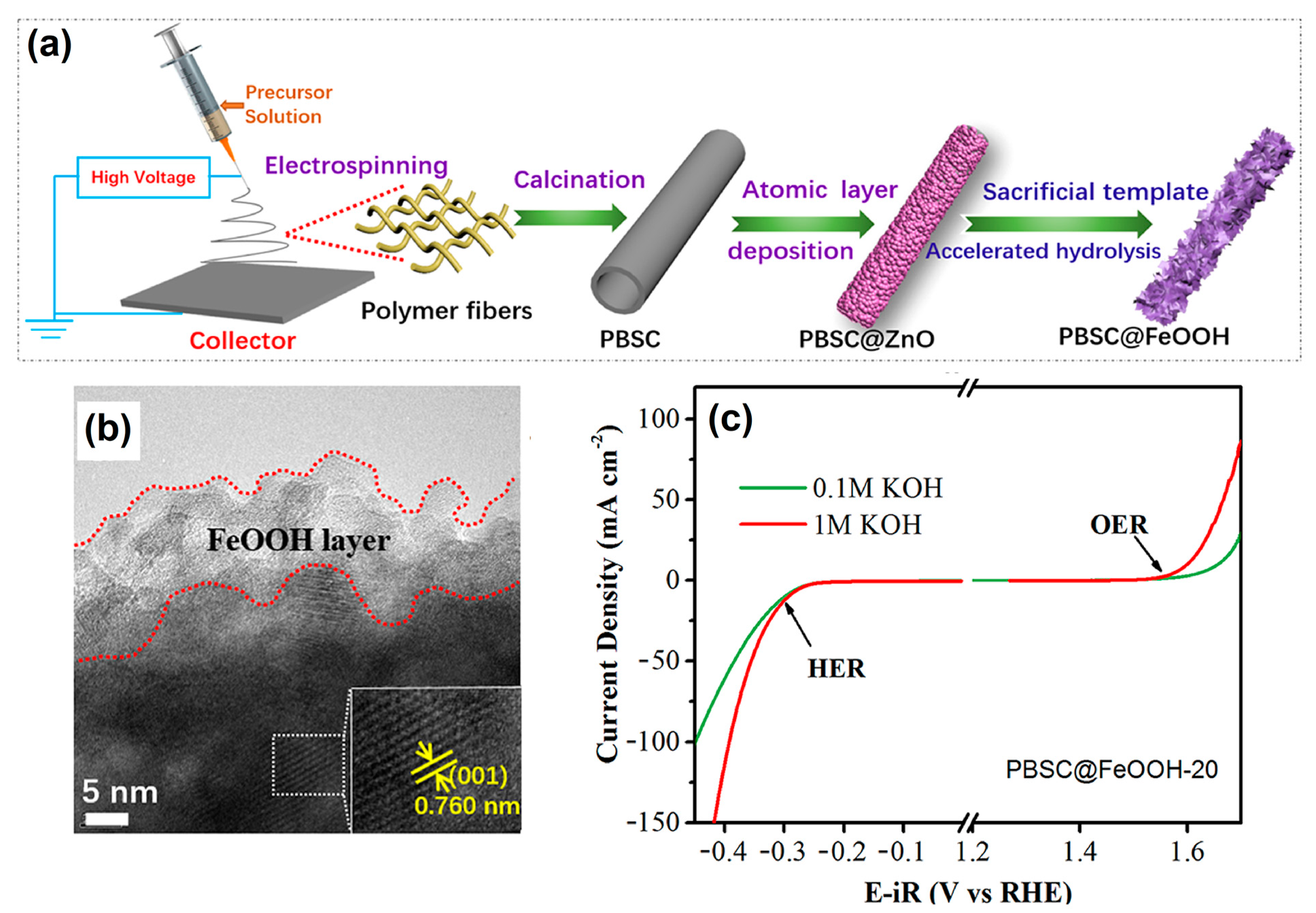

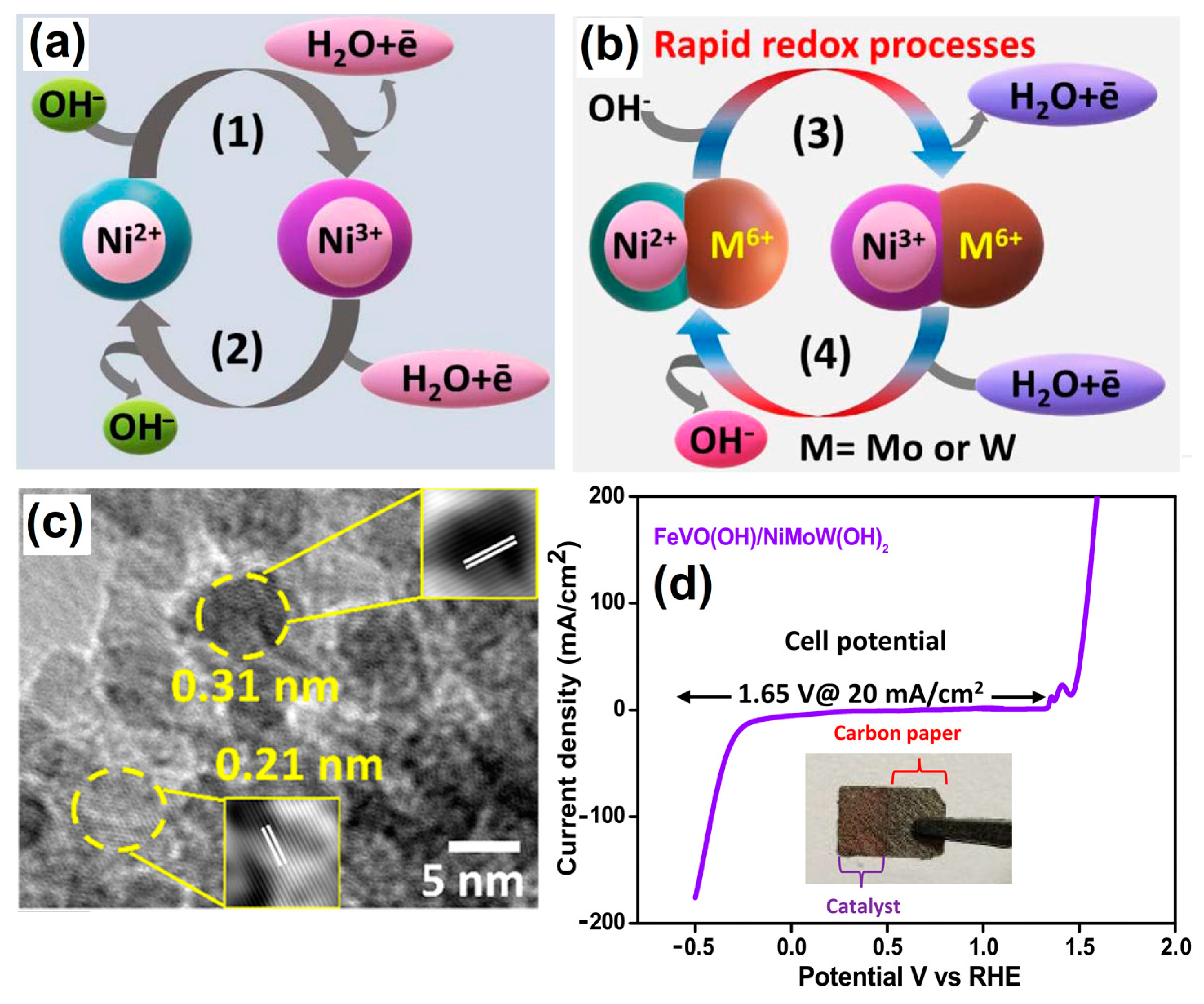
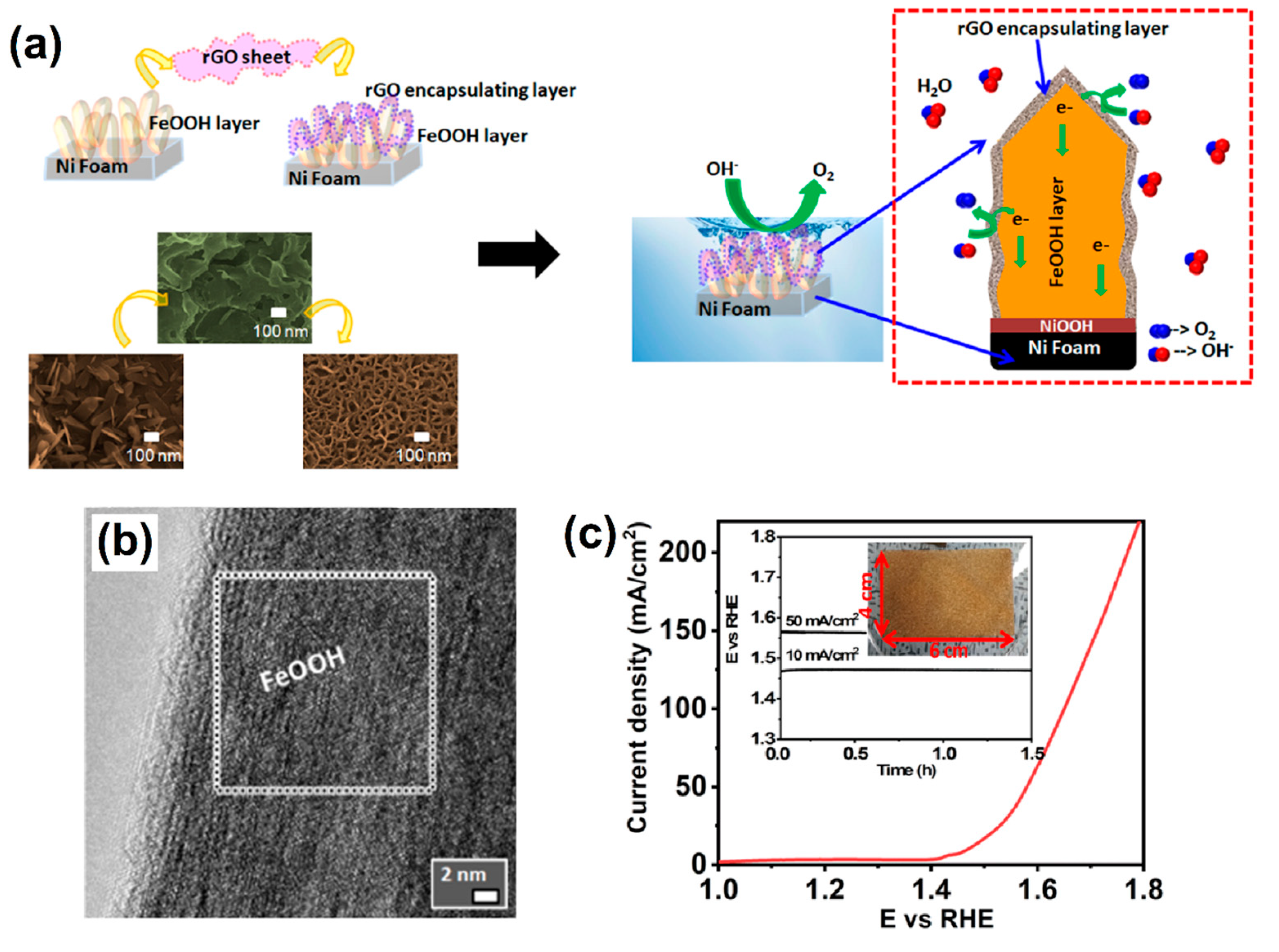
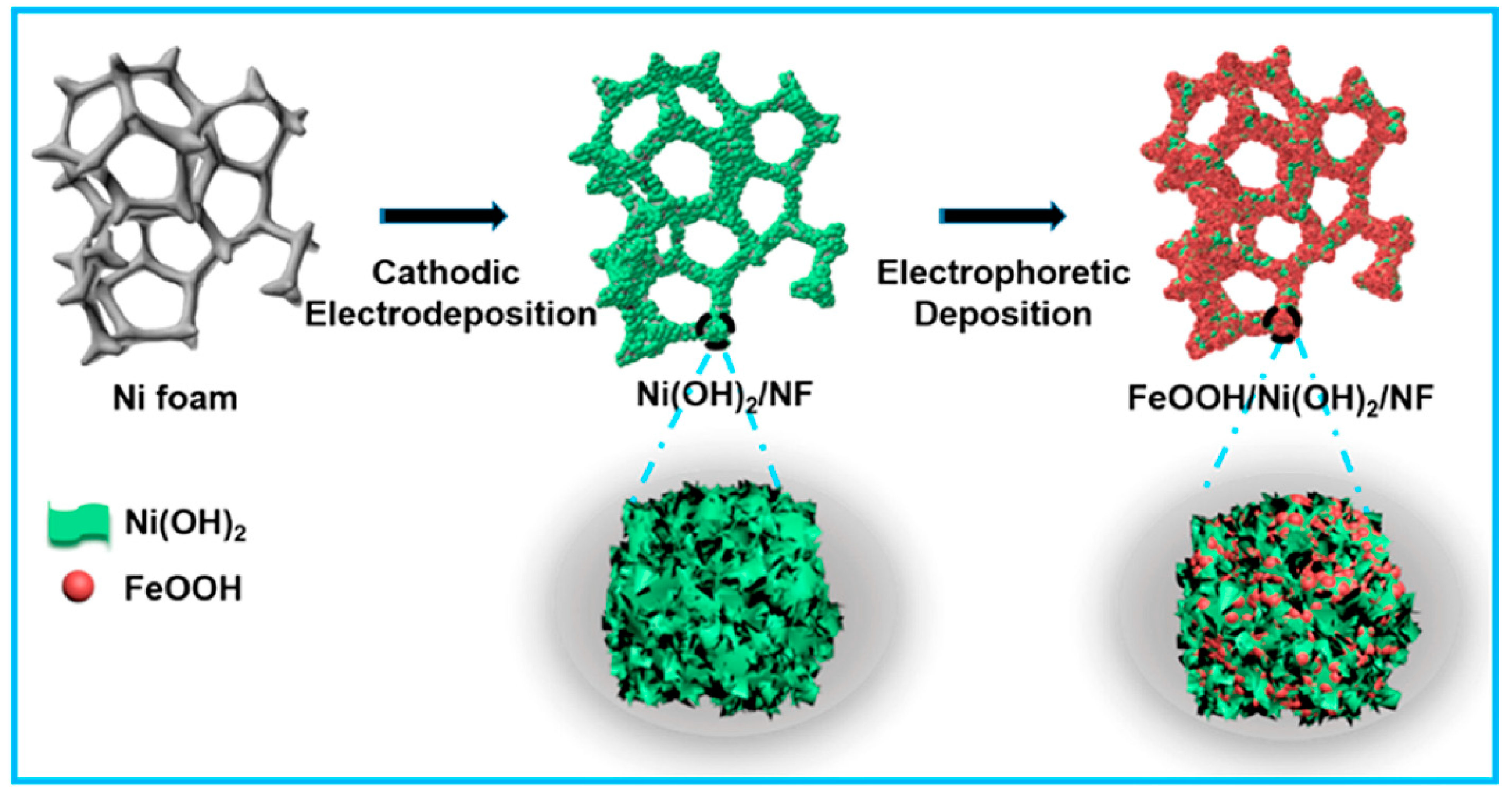

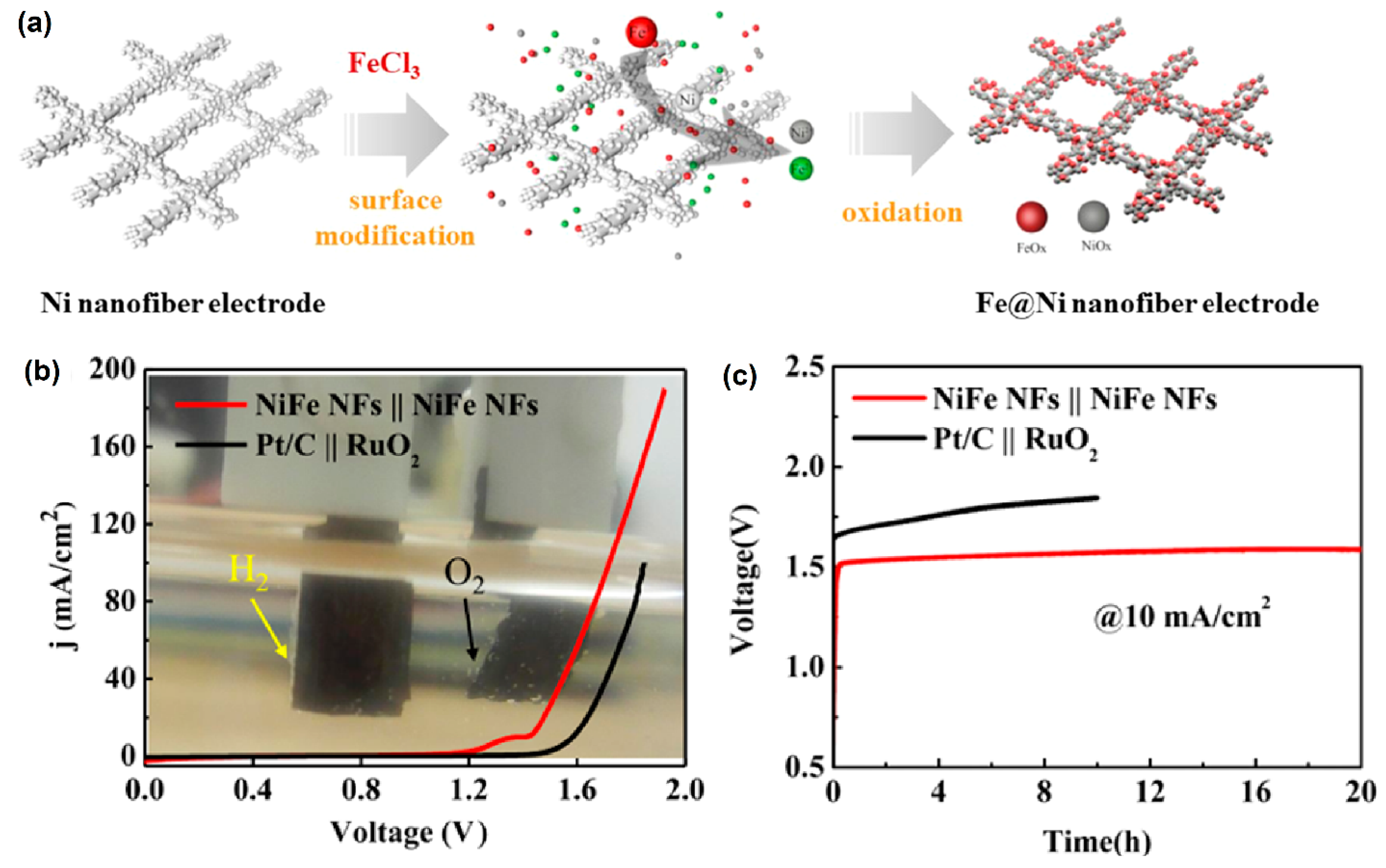
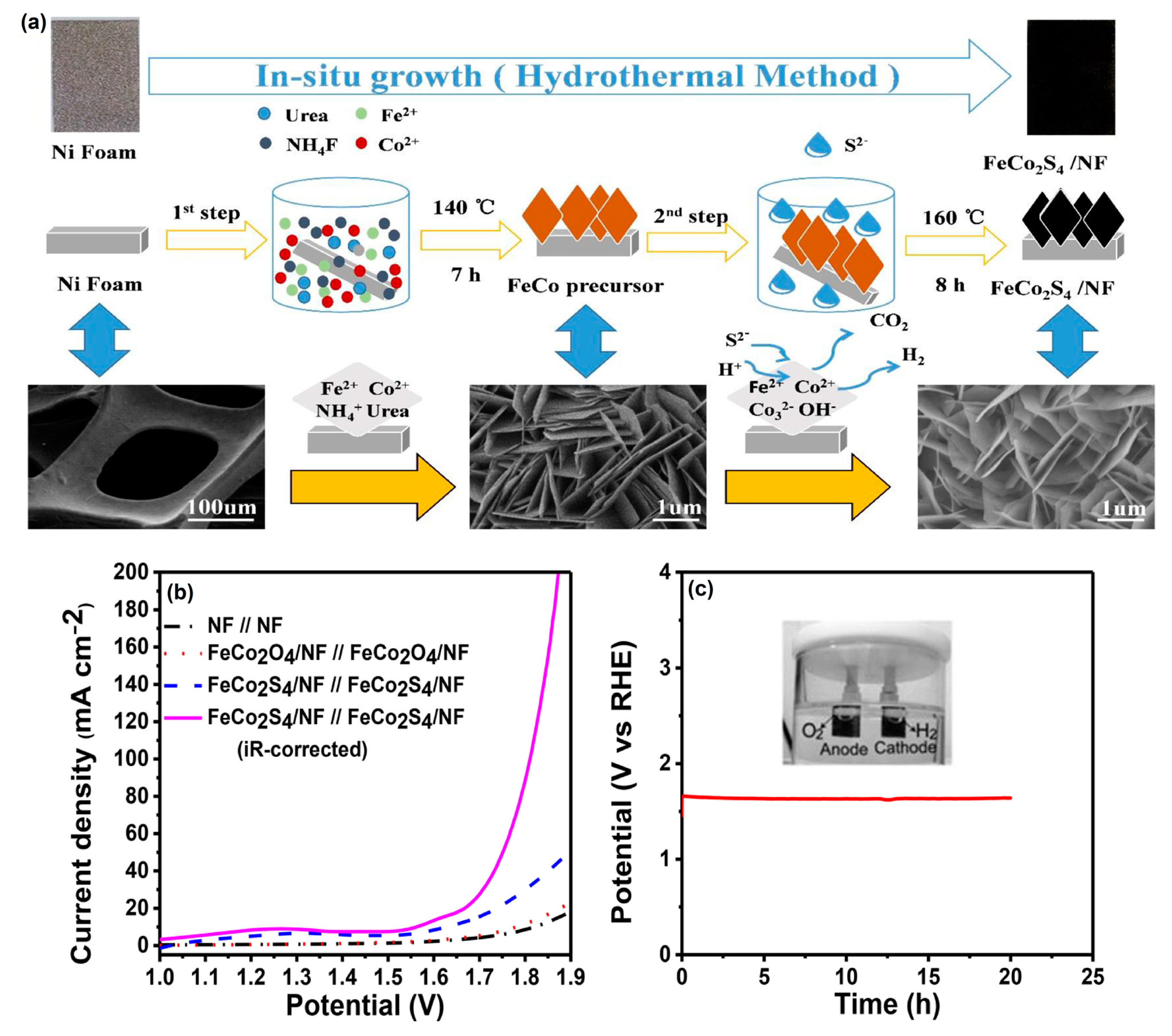


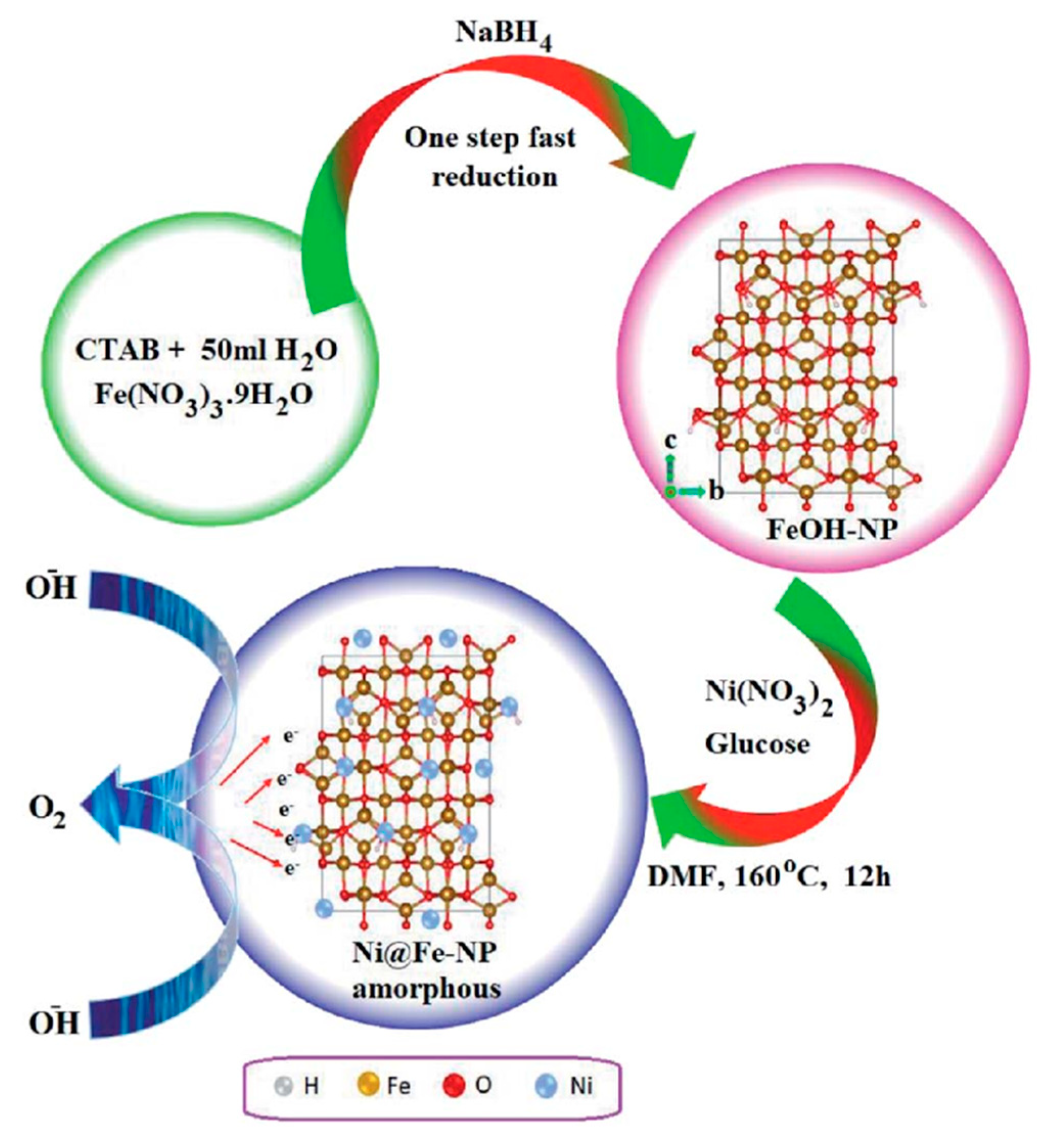

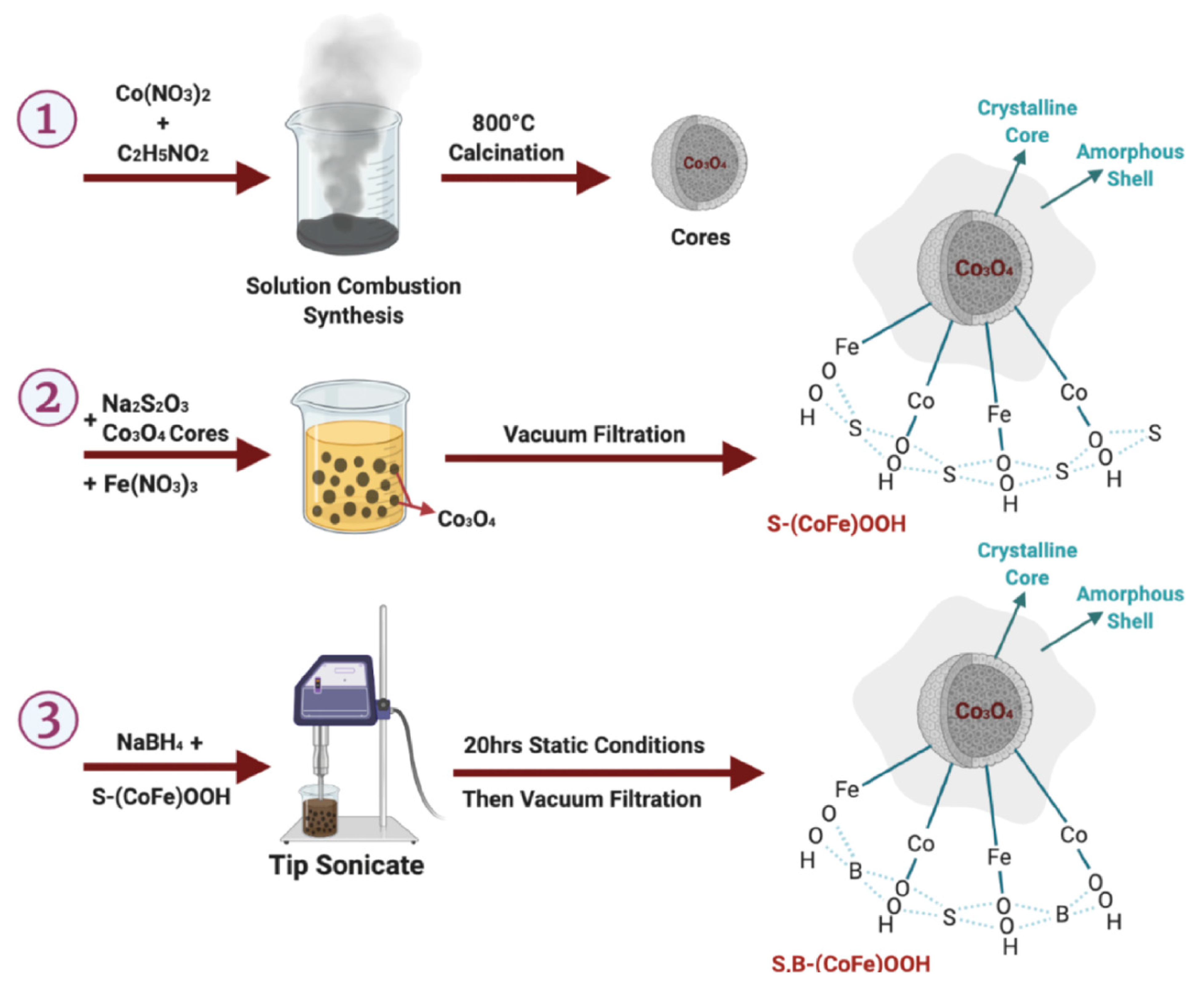

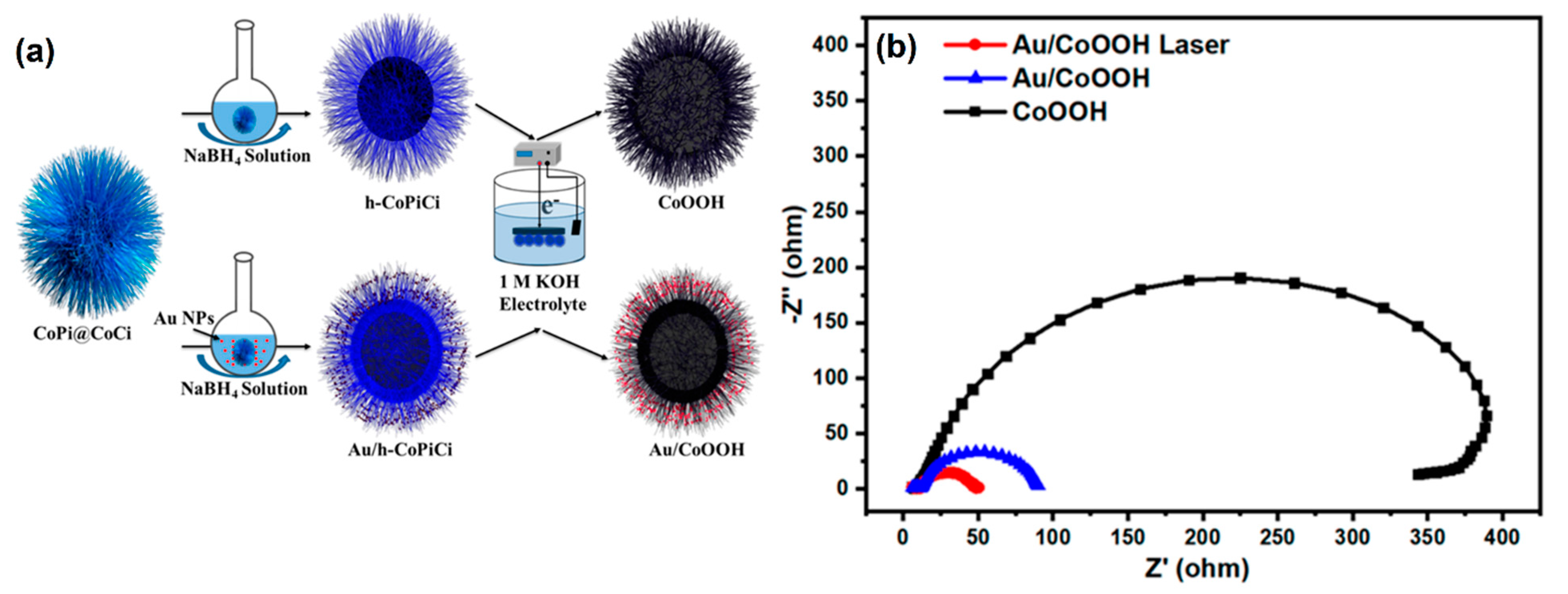
| Electrocatalyst | Medium (M) | Over Potential (V) | Tafel Slope (mV dec−1) | Current Density (mA cm−2) | Specific Capacity (mAh g−1) | Stability (Cycles) | Ref. |
|---|---|---|---|---|---|---|---|
| a FeCo2Ox(OH)y/GO | 0.1 NaOH | 0.305 | 43.7 | 10 | − | − | [26] |
| b 3D-FeCoOOH/CC | 1 KOH | 0.259 | 34.9 | 10 | − | − | [27] |
| c Spindle-FON/CC | - | 0.216 | 73.4 | 10 | − | − | [28] |
| d NiFeOOH(S, Se) | 1 KOH | 0.195 | 31.99 | 10 | − | − | [29] |
| e FeCoNi(S) | 1 KOH | 0.293 | − | 500 | − | 2000 h | [30] |
| f γ-FeOOH/N,S-C | 0.1 NaOH | 0.123 | 79.6 | 92 | 740 | 5000 | [31] |
| g RuO2/MnOOH/C | 1 LiPF6 | − | − | 0.2 | 1000 | 100 | [32] |
| h γ-NiOOH | 1 KOH | 0.81 | 328 | 12 | − | 133 | [33] |
| i CoFe-OH@FeOOH | 1 KOH | 0.200 | 48 | 10 | − | 500 s | [34] |
| j 3D CoFe-OOH@Co2P/NF | 1 KOH | 0.199 | 39 | 30 | − | 24 h | [35] |
Disclaimer/Publisher’s Note: The statements, opinions and data contained in all publications are solely those of the individual author(s) and contributor(s) and not of MDPI and/or the editor(s). MDPI and/or the editor(s) disclaim responsibility for any injury to people or property resulting from any ideas, methods, instructions or products referred to in the content. |
© 2023 by the authors. Licensee MDPI, Basel, Switzerland. This article is an open access article distributed under the terms and conditions of the Creative Commons Attribution (CC BY) license (https://creativecommons.org/licenses/by/4.0/).
Share and Cite
Chen, T.-W.; Chen, S.-M.; Anushya, G.; Kannan, R.; Veerakumar, P.; Alam, M.M.; Alargarsamy, S.; Ramachandran, R. Metal-Oxides- and Metal-Oxyhydroxides-Based Nanocomposites for Water Splitting: An Overview. Nanomaterials 2023, 13, 2012. https://doi.org/10.3390/nano13132012
Chen T-W, Chen S-M, Anushya G, Kannan R, Veerakumar P, Alam MM, Alargarsamy S, Ramachandran R. Metal-Oxides- and Metal-Oxyhydroxides-Based Nanocomposites for Water Splitting: An Overview. Nanomaterials. 2023; 13(13):2012. https://doi.org/10.3390/nano13132012
Chicago/Turabian StyleChen, Tse-Wei, Shen-Ming Chen, Ganesan Anushya, Ramanujam Kannan, Pitchaimani Veerakumar, Mohammed Mujahid Alam, Saranvignesh Alargarsamy, and Rasu Ramachandran. 2023. "Metal-Oxides- and Metal-Oxyhydroxides-Based Nanocomposites for Water Splitting: An Overview" Nanomaterials 13, no. 13: 2012. https://doi.org/10.3390/nano13132012
APA StyleChen, T.-W., Chen, S.-M., Anushya, G., Kannan, R., Veerakumar, P., Alam, M. M., Alargarsamy, S., & Ramachandran, R. (2023). Metal-Oxides- and Metal-Oxyhydroxides-Based Nanocomposites for Water Splitting: An Overview. Nanomaterials, 13(13), 2012. https://doi.org/10.3390/nano13132012


_Hui.png)





